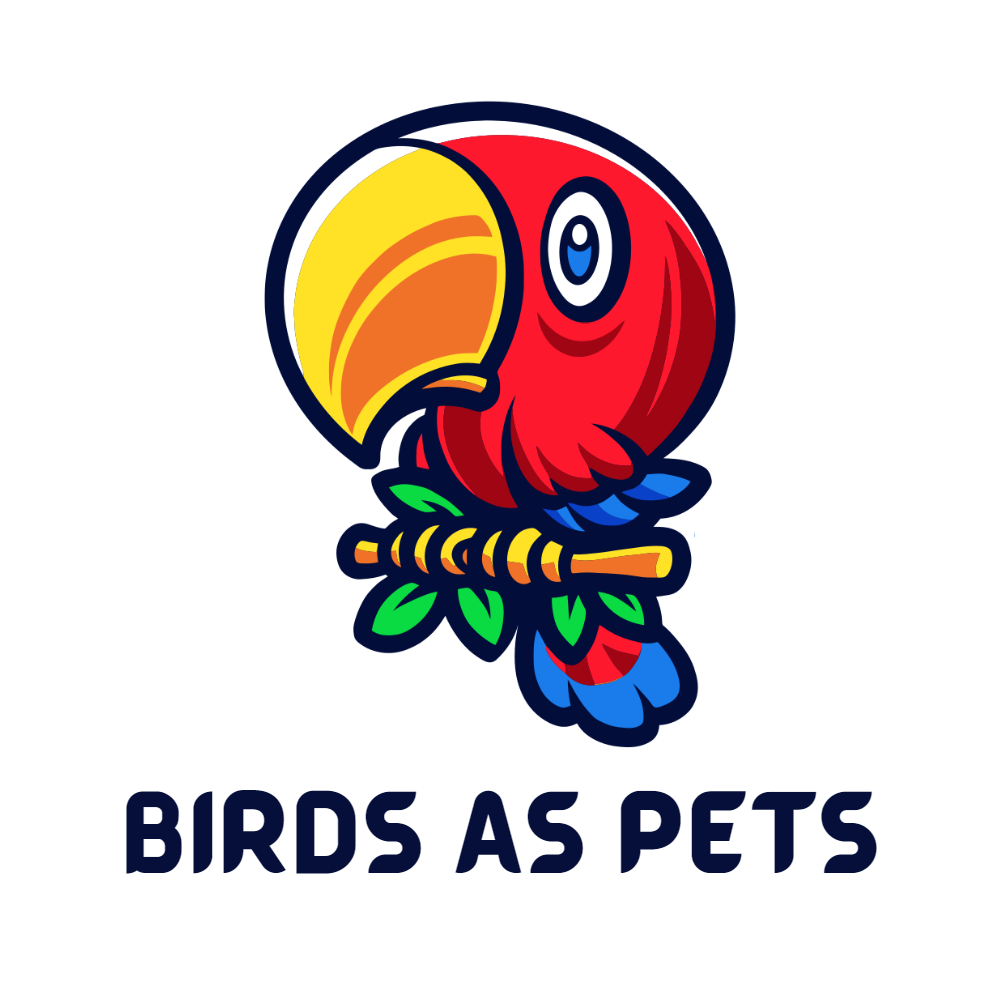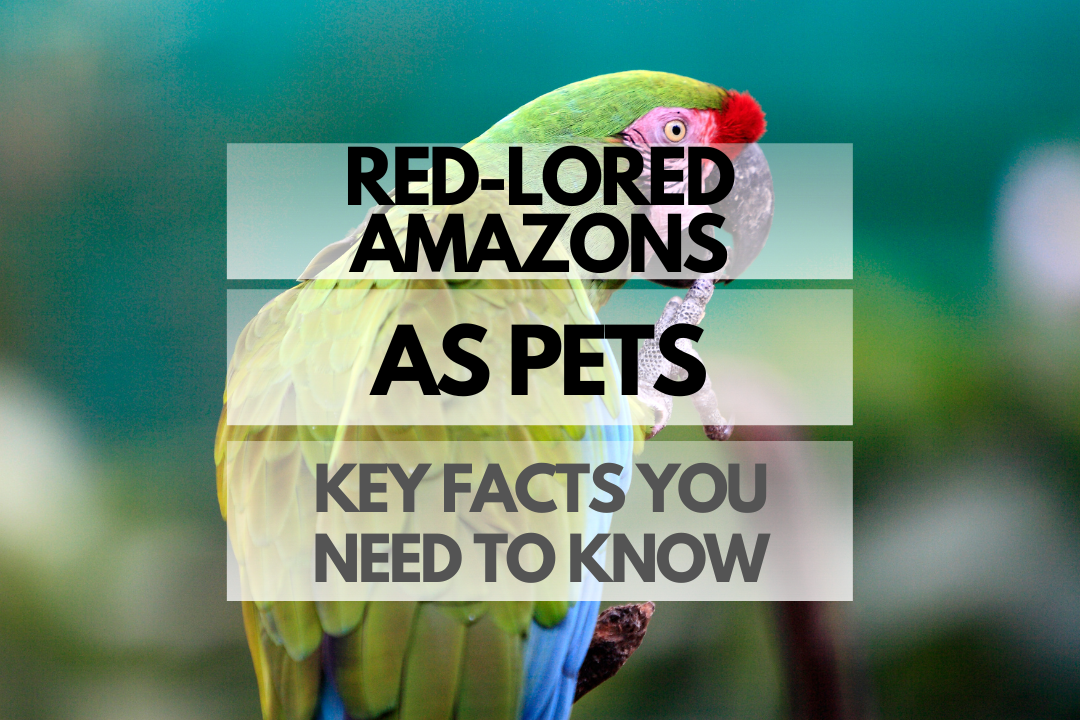If you’re considering a Red-lored Amazon as a pet, you’re in for a delightful and dynamic experience. These intelligent and social birds make fantastic companions for the right owner. In this article, we’ll cover everything you need to know about Red-lored Amazons, from their natural habitat to their lifespan, and how to properly care for them.
Quick Reference Table: Red-lored Amazon Facts
| Fact | Description |
|---|---|
| Scientific Name | Amazona autumnalis |
| Size | 12-15 inches (30-38 cm) |
| Weight | 12-20 oz (340-565 g) |
| Lifespan | 40-60 years |
| Color | Primarily green with red forehead, bluish cheeks, and yellow on the wings |
| Talking Ability | Good; known for their ability to mimic speech and sounds |
Where Do Wild Red-lored Amazons Live?
Wild Red-lored Amazons are native to Central America, with their range extending across Mexico, Belize, Guatemala, Honduras, Nicaragua, Costa Rica, and Panama. They inhabit various habitats, including tropical rainforests, mangroves, and woodlands. These social birds are usually found in flocks and are known for their loud calls and lively behavior.
Red-lored Amazon Lifespan: How Long Do They Live as Pets?
Red-lored Amazons are known for their long lifespans, often living up to 40-60 years in captivity with proper care. This longevity means that owning a Red-lored Amazon is a significant time commitment, and potential owners should be prepared to care for their bird throughout its entire life. It’s essential to provide a balanced diet, regular veterinary care, and mental stimulation to ensure a long and healthy life for your Red-lored Amazon.
Are Red-lored Amazons Good Pets?
Red-lored Amazons can make excellent pets for the right owner. They are known for their intelligence, strong personalities, and good talking abilities. These birds are social creatures who enjoy being around their human family members and can form strong bonds with their caregivers. However, they can also be demanding and require a significant amount of attention and mental stimulation. Potential owners should carefully consider their lifestyle and the long-term commitment required before bringing a Red-lored Amazon into their home.
Are Red-lored Amazons as Pets Good for Beginners?
Red-lored Amazons may not be the best choice for first-time bird owners due to their demanding personalities and long lifespans. They require consistent social interaction, mental stimulation, and hands-on care. Potential owners should have experience with birds or be willing to invest the time and effort to learn about proper care and handling before bringing a Red-lored Amazon into their home.
Are Red-lored Amazons Easy to Care For?
While no bird is truly easy to care for, Red-lored Amazons are relatively hardy and adaptable. They require a balanced diet, a large and secure cage, regular mental stimulation, and consistent social interaction. With proper care, they can be healthy and happy pets, but it’s essential to understand and be prepared to meet their specific needs.
Red-lored Amazon Pros and Cons
| Pros | Cons |
|---|---|
| Intelligent and social | Can be demanding |
| Good talking ability | May be loud and vocal |
| Long lifespan | Requires a significant time commitment |
| Adaptable and hardy | Not ideal for first-time bird owners |
Prices for Red-lored Amazons can vary depending on factors such as age, sex, and breeder reputation. On average, you can expect to pay between $800 and $1,500 for a Red-lored Amazon. Keep in mind that the initial purchase price is only part of the overall cost. You’ll also need to budget for a large cage, toys, perches, food, and regular veterinary care. Ongoing monthly expenses can range from $50 to $100, depending on the specific needs of your bird.
Where to Buy Red-lored Amazons
If you’re looking to purchase a Red-lored Amazon, it’s essential to find a reputable breeder or rescue organization. This will help ensure that you’re getting a healthy bird that has been well-socialized and cared for. You can start by reaching out to local avian veterinarians, bird clubs, or online forums for recommendations. Always take the time to research breeders and ask questions about their birds’ health, diet, and socialization before making a decision.
Caring for Red-lored Amazons
Red-lored Amazon Food
A balanced diet is essential for keeping your Red-lored Amazon healthy. Their diet should consist of pellets specifically formulated for parrots, fresh fruits and vegetables, and a limited amount of seeds and nuts. It’s important to avoid feeding your bird an exclusively seed-based diet, as this can lead to nutritional deficiencies. Offer a variety of foods and monitor your bird’s weight and overall health to ensure they’re getting the proper nutrition.
Health and Common Issues
Red-lored Amazons are relatively hardy birds, but like any pet, they can be susceptible to certain health issues. Some common health problems include obesity, feather plucking, and respiratory infections. Regular veterinary care, including annual check-ups and any necessary vaccinations, is essential to keeping your bird healthy. In addition, providing a clean environment, proper nutrition, and mental stimulation can help prevent many common issues.
Signs of Healthy Red-lored Amazon vs. a Sick One
| Healthy Red-lored Amazon | Sick Red-lored Amazon |
|---|---|
| Bright, clear eyes | Cloudy, watery, or crusty eyes |
| Smooth, well-groomed feathers | Ruffled, plucked, or discolored feathers |
| Active and alert | Lethargic or unresponsive |
| Normal droppings | Abnormal droppings (color, consistency, frequency) |
| Good appetite | Loss of appetite or sudden weight loss |
| No difficulty breathing | Wheezing, labored breathing, or discharge from the nostrils |
Red-lored Amazons Pet Insurance
- Nationwide Pet Insurance
- Healthy Paws Pet Insurance
- PetPlan Insurance
- Embrace Pet Insurance
- Trupanion Pet Insurance
Personality and Behavior
Red-lored Amazons have a charming personality and can be quite entertaining. They are intelligent, curious, and active birds, known for their strong will and playfulness. They enjoy interacting with their human family, but also need time to play and explore on their own. Red-lored Amazons can be affectionate and form strong bonds with their caregivers, but they may also show a preference for one person and be territorial around others.
Are Red-lored Amazons Social?
Yes, Red-lored Amazons are social creatures who thrive on interaction and companionship. They enjoy being with their human family and other birds, though they may need time to adjust to new companions. It’s essential to provide them with plenty of mental and physical stimulation to keep them happy and healthy. Inadequate social interaction can lead to boredom, stress, and behavioral issues such as feather plucking and aggression.
Speech and Noise of Red-lored Amazons
Red-lored Amazons are known for their excellent talking abilities. They can learn to mimic speech and other sounds with remarkable clarity. These birds enjoy practicing their vocalizations and may engage in conversations with their caregivers. However, they can also be quite loud, especially when excited or seeking attention. Potential owners should be prepared for their vocal nature and consider whether their living situation can accommodate a sometimes noisy pet.
Similar Species to Red-lored Amazons
- Blue-fronted Amazon (Amazona aestiva)
- Yellow-headed Amazon (Amazona oratrix)
- Festive Amazon (Amazona festiva)
- Mealy Amazon (Amazona farinosa)
- Orange-winged Amazon (Amazona amazonica)
Can Red-lored Amazons Live With Other Pets and Birds?
Red-lored Amazons can live with other pets and birds, but proper introductions and monitoring are essential. They may get along well with other similarly sized birds, but they can be territorial and may not tolerate smaller birds. It’s crucial to supervise interactions between your Red-lored Amazon and other pets, ensuring that all animals have their own space and feel secure. Keep in mind that some pets, such as dogs and cats, may not be suitable companions for a Red-lored Amazon.
Are Red-lored Amazons Legal to Have as Pets?
Red-lored Amazons are generally legal to keep as pets in most countries and states. However, it’s essential to check local laws and regulations before bringing a Red-lored Amazon into your home. Some areas may require permits, while others may restrict or prohibit the ownership of certain exotic birds. It’s crucial to ensure you’re following all applicable laws and regulations to avoid any potential issues.
Additional Resources
- Book: “Amazon Parrots: A Complete Pet Owner’s Manual” by Werner Lantermann
- Forum: Avian Avenue (https://www.avianavenue.com/)
- Facebook Group: Amazon Parrot Owners (https://www.facebook.com/groups/AmazonParrotOwners/)
- Scientific Article: “Behavioral and physiological predictors of guide dog success” (Journal of Veterinary Behavior)
FAQ for Red-lored Amazons as Pets
Do Red-lored Amazons talk?
Yes, Red-lored Amazons are known for their ability to talk and mimic sounds. They can learn a variety of words and phrases and may engage in conversations with their caregivers.
Are Red-lored Amazons suitable for families with young kids?
Red-lored Amazons can be suitable for families with young kids, but it’s essential to teach children how to interact with the bird safely and respectfully. These birds can be territorial and may bite if they feel threatened, so proper supervision andeducation are crucial for a harmonious relationship between a Red-lored Amazon and young children.
Can Red-lored Amazons be trained?
Yes, Red-lored Amazons can be trained to perform tricks, talk, and display desirable behaviors. They are intelligent birds that respond well to positive reinforcement training methods. Consistency, patience, and rewards are key to successful training sessions.
How do I know what gender Red-lored Amazons are?
Determining the gender of a Red-lored Amazon can be challenging, as males and females look very similar. The most reliable method is to have a DNA test performed by a veterinarian or specialized laboratory.
What is the lifespan of a Red-lored Amazon?
With proper care, a Red-lored Amazon can live between 40 and 60 years. Providing a balanced diet, regular veterinary care, and a stimulating environment can help ensure a long and healthy life for your pet.
What should I feed my Red-lored Amazon?
A balanced diet for a Red-lored Amazon should consist of high-quality pellets, fresh fruits, vegetables, and a limited amount of seeds and nuts. Avoid feeding your bird foods that are high in fat, salt, or sugar, and always consult your veterinarian before introducing new foods.

